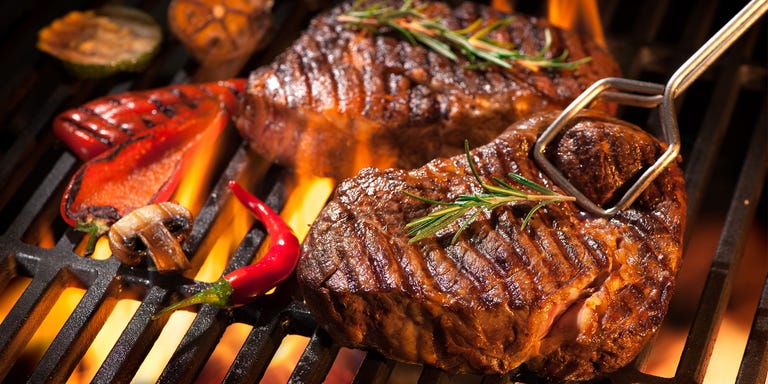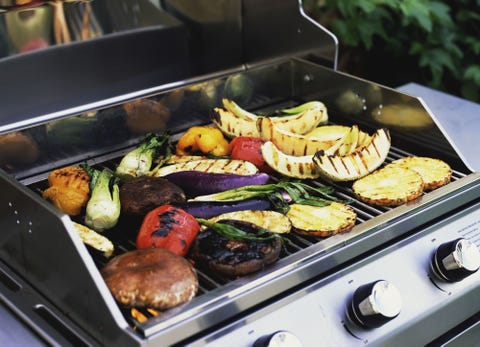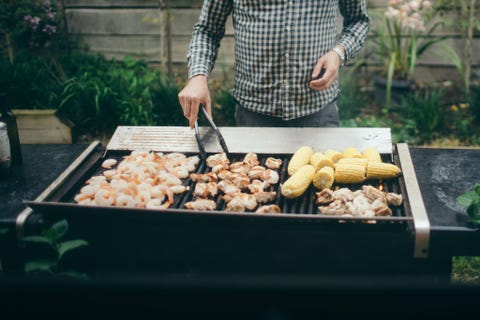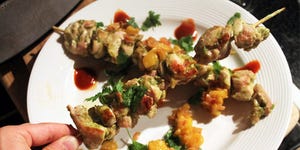

There’s nothing quite like cooking food over an open flame. The techniques are simple, cleanup is easy, and grilled food tastes amazing.
Fire up the grill, pick whichever recipe sounds the best, use this guide as a primer to get started.
1. Choose a Grill
Grilling purists agree charcoal provides the most flavorful meals, but the convenience and speed of gas grills has made them far and away the most popular choice for home grills.

Getty ImagesSheri L Giblin
Charcoal grills are great for smaller budgets and when you’ve got time to wait for the coals, but there is more to cleanup and things can get dirty. Gas-powered propane grills simply require a 20-gallon propane tank and fire up at the touch of a button. Some gas grills can also be setup to run from the gas line in your home, which gets rid of the propane tank. You can inject flavor into your gas grill food by setting a piece of mesquite or cherry onto the grill as it’s cooking, which adds depth to your meal.
We’ve done the homework for you and selected the best grills and smokers we could find. Don’t forget your grilling accessories as well, including a digital meat thermometer which is one of the best investments you can make. It removes the guessing game of whether meat is done, and meals are never undercooked.
2. Prepare Your Space
It helps to have a side table to prep and plate your food as you place it on the grill. Many grills include a small side table and possibly even an extra burner to cook food in a pan or pot, alongside your grilled food. Make sure you have a clear area to set down a plate of food, and hold any accessories you’ll need like a brush, tongs, and thermometer. A grill light is also helpful when cooking after dark.
3. Select a Meal
There are three basic settings to consider when grilling food. The first is whether you will be using direct or indirect heat, second is how hot the grill should be, and third is how long you should cook your food. You can also choose to grill with the lid on or off which regulates the temperature.
Just as you would preheat your oven, always preheat your grill before cooking. No matter what temperature you will be cooking at, it’s best to preheat your grill on high and then turn it down to whatever setting you need to grill at.
Spray a thin layer of cooking oil on your grill as it’s heating up to prevent food from sticking.

Getty Images
Beef
Steak, hamburgers, and hot dogs are the most popular foods to grill, and in general all beef products should be cooked over direct heat and with the grill on the high setting. The heat can be turned down slightly for hot dogs and thin cut steaks.
Steaks and burgers cooked to medium are typically finished in less than 10 minutes, so don’t wander off or get distracted or you can easily overcook your food. Steak in particular needs time to “rest” after you’ve removed it from the grill, so let it sit covered in foil for about five minutes before cutting into it.
Pro tip: For more evenly-cooked, tender, and flavorful steaks off the grill, try scoring your meat! Using the tip of a sharp knife, first make shallow (about 1/8 inch deep) cuts across the grain one way, then the other way (perpendicular to first set of cuts). Repeat on the other side. Season the steak, then grill it on medium-high for a minute or two less per side.
Chicken
Grilling chicken takes a bit more time and should be done at a medium-heat setting. Chicken can easily dry out on a grill, so it’s best to cook it slowly and brine it overnight or apply a marinade or sauce to keep it moist. Indirect heat works best for bone-in chicken and give it at least 30-40 minutes to cook. Always use your meat thermometer to determine when the chicken is ready.
Pork
Grilling pork is similar to beef, use direct heat but turn down the temperature to medium-heat. Pork chops can cook quickly and depending on the thickness only require 2-4 minutes per side before they’re done.

Getty ImagesIppei Naoi
Pro tip: Use a meat thermometer! Cutting into meat to make sure it’s done spills juices and looks messy. More importantly, it’s not as accurate as a thermometer. Once the meat is deemed ready to be taken off the grill, it’s still not ready to be eaten. Letting it rest for a few minutes helps seal in those juices.
Seafood
Fish cooks great on the grill and won’t leave your kitchen with a funky smell. Use direct medium to medium-high heat and plenty of cooking oil to prevent fish from sticking. Fish and seafood also does well cooked in foil with butter and seasonings, which prevents the fish from sticking to the grill.
Shellfish can be grilled in under 8 minutes, and large shrimp make for a quick and tasty meal on any sized grill.
Vegetables
With a gas grill you can grill asparagus, eggplant, and zucchini, right next to your steak or chicken, just make sure you have the heat set to medium and be prepared to quickly remove your veggies as they can overcook quickly. Olive oil and salt and pepper are the only seasonings you need to prep your veggies.
Corn is great on the grill but be patient as it can take about 30 minutes for corn in the husk to cook on the grill. Removing the husk lessens the cooking time, but some think that drys it out.
4. Cleanup
Proper cleanup is the key to your next successful grilling session. Use a wire brush immediately after cooking to remove excess oil and food particles. Keeping the grill grates clean prevents the buildup of bacteria, discourages bugs and pests from trying to check out your grill, and prevents carbon buildup which can eventually alter the performance of your grill.
Use a grill cover when not in use, which will protect it from the elements and prolong it’s life.



From: Popular Mechanics
Source: Read Full Article